Fenoldopam_mesylate_SDS_MedChemExpress
Gelucire-14-44-SDS-MedChemExpress

Inhibitors, Agonists, Screening LibrariesSafety Data Sheet Revision Date:Nov.-23-2018Print Date:Nov.-23-20181. PRODUCT AND COMPANY IDENTIFICATION1.1 Product identifierProduct name :Gelucire 14/44Catalog No. :HY-Y1892CAS No. :121548-04-71.2 Relevant identified uses of the substance or mixture and uses advised againstIdentified uses :Laboratory chemicals, manufacture of substances.1.3 Details of the supplier of the safety data sheetCompany:MedChemExpress USATel:609-228-6898Fax:609-228-5909E-mail:sales@1.4 Emergency telephone numberEmergency Phone #:609-228-68982. HAZARDS IDENTIFICATION2.1 Classification of the substance or mixtureNot a hazardous substance or mixture.2.2 GHS Label elements, including precautionary statementsNot a hazardous substance or mixture.2.3 Other hazardsNone.3. COMPOSITION/INFORMATION ON INGREDIENTS3.1 SubstancesSynonyms:NoneFormula:N/AMolecular Weight:N/ACAS No. :121548-04-74. FIRST AID MEASURES4.1 Description of first aid measuresEye contactRemove any contact lenses, locate eye-wash station, and flush eyes immediately with large amounts of water. Separate eyelids with fingers to ensure adequate flushing. Promptly call a physician.Skin contactRinse skin thoroughly with large amounts of water. Remove contaminated clothing and shoes and call a physician.InhalationImmediately relocate self or casualty to fresh air. If breathing is difficult, give cardiopulmonary resuscitation (CPR). Avoid mouth-to-mouth resuscitation.IngestionWash out mouth with water; Do NOT induce vomiting; call a physician.4.2 Most important symptoms and effects, both acute and delayedThe most important known symptoms and effects are described in the labelling (see section 2.2).4.3 Indication of any immediate medical attention and special treatment neededTreat symptomatically.5. FIRE FIGHTING MEASURES5.1 Extinguishing mediaSuitable extinguishing mediaUse water spray, dry chemical, foam, and carbon dioxide fire extinguisher.5.2 Special hazards arising from the substance or mixtureDuring combustion, may emit irritant fumes.5.3 Advice for firefightersWear self-contained breathing apparatus and protective clothing.6. ACCIDENTAL RELEASE MEASURES6.1 Personal precautions, protective equipment and emergency proceduresUse full personal protective equipment. Avoid breathing vapors, mist, dust or gas. Ensure adequate ventilation. Evacuate personnel to safe areas.Refer to protective measures listed in sections 8.6.2 Environmental precautionsTry to prevent further leakage or spillage. Keep the product away from drains or water courses.6.3 Methods and materials for containment and cleaning upAbsorb solutions with finely-powdered liquid-binding material (diatomite, universal binders); Decontaminate surfaces and equipment by scrubbing with alcohol; Dispose of contaminated material according to Section 13.7. HANDLING AND STORAGE7.1 Precautions for safe handlingAvoid inhalation, contact with eyes and skin. Avoid dust and aerosol formation. Use only in areas with appropriate exhaust ventilation.7.2 Conditions for safe storage, including any incompatibilitiesKeep container tightly sealed in cool, well-ventilated area. Keep away from direct sunlight and sources of ignition.Recommended storage temperature:Pure form-20°C 3 years4°C 2 yearsIn solvent-80°C 6 months-20°C 1 monthShipping at room temperature if less than 2 weeks.7.3 Specific end use(s)No data available.8. EXPOSURE CONTROLS/PERSONAL PROTECTION8.1 Control parametersComponents with workplace control parametersThis product contains no substances with occupational exposure limit values.8.2 Exposure controlsEngineering controlsEnsure adequate ventilation. Provide accessible safety shower and eye wash station.Personal protective equipmentEye protection Safety goggles with side-shields.Hand protection Protective gloves.Skin and body protection Impervious clothing.Respiratory protection Suitable respirator.Environmental exposure controls Keep the product away from drains, water courses or the soil. Cleanspillages in a safe way as soon as possible.9. PHYSICAL AND CHEMICAL PROPERTIES9.1 Information on basic physical and chemical propertiesAppearance White to off-white (Oil)Odor No data availableOdor threshold No data availablepH No data availableMelting/freezing point No data availableBoiling point/range No data availableFlash point No data availableEvaporation rate No data availableFlammability (solid, gas)No data availableUpper/lower flammability or explosive limits No data availableVapor pressure No data availableVapor density No data availableRelative density No data availableWater Solubility No data availablePartition coefficient No data availableAuto-ignition temperature No data availableDecomposition temperature No data availableViscosity No data availableExplosive properties No data availableOxidizing properties No data available9.2 Other safety informationNo data available.10. STABILITY AND REACTIVITY10.1 ReactivityNo data available.10.2 Chemical stabilityStable under recommended storage conditions.10.3 Possibility of hazardous reactionsNo data available.10.4 Conditions to avoidNo data available.10.5 Incompatible materialsStrong acids/alkalis, strong oxidising/reducing agents.10.6 Hazardous decomposition productsUnder fire conditions, may decompose and emit toxic fumes.Other decomposition products - no data available.11.TOXICOLOGICAL INFORMATION11.1 Information on toxicological effectsAcute toxicityClassified based on available data. For more details, see section 2Skin corrosion/irritationClassified based on available data. For more details, see section 2Serious eye damage/irritationClassified based on available data. For more details, see section 2Respiratory or skin sensitizationClassified based on available data. For more details, see section 2Germ cell mutagenicityClassified based on available data. For more details, see section 2CarcinogenicityIARC: No component of this product present at a level equal to or greater than 0.1% is identified as probable, possible or confirmed human carcinogen by IARC.ACGIH: No component of this product present at a level equal to or greater than 0.1% is identified as a potential or confirmed carcinogen by ACGIH.NTP: No component of this product present at a level equal to or greater than 0.1% is identified as a anticipated or confirmed carcinogen by NTP.OSHA: No component of this product present at a level equal to or greater than 0.1% is identified as a potential or confirmed carcinogen by OSHA.Reproductive toxicityClassified based on available data. For more details, see section 2Specific target organ toxicity - single exposureClassified based on available data. For more details, see section 2Specific target organ toxicity - repeated exposureClassified based on available data. For more details, see section 2Aspiration hazardClassified based on available data. For more details, see section 212. ECOLOGICAL INFORMATION12.1 ToxicityNo data available.12.2 Persistence and degradabilityNo data available.12.3 Bioaccumlative potentialNo data available.12.4 Mobility in soilNo data available.12.5 Results of PBT and vPvB assessmentPBT/vPvB assessment unavailable as chemical safety assessment not required or not conducted.12.6 Other adverse effectsNo data available.13. DISPOSAL CONSIDERATIONS13.1 Waste treatment methodsProductDispose substance in accordance with prevailing country, federal, state and local regulations.Contaminated packagingConduct recycling or disposal in accordance with prevailing country, federal, state and local regulations.14. TRANSPORT INFORMATIONDOT (US)This substance is considered to be non-hazardous for transport.IMDGThis substance is considered to be non-hazardous for transport.IATAThis substance is considered to be non-hazardous for transport.15. REGULATORY INFORMATIONSARA 302 Components:No chemicals in this material are subject to the reporting requirements of SARA Title III, Section 302.SARA 313 Components:This material does not contain any chemical components with known CAS numbers that exceed the threshold (De Minimis) reporting levels established by SARA Title III, Section 313.SARA 311/312 Hazards:No SARA Hazards.Massachusetts Right To Know Components:No components are subject to the Massachusetts Right to Know Act.Pennsylvania Right To Know Components:No components are subject to the Pennsylvania Right to Know Act.New Jersey Right To Know Components:No components are subject to the New Jersey Right to Know Act.California Prop. 65 Components:This product does not contain any chemicals known to State of California to cause cancer, birth defects, or anyother reproductive harm.16. OTHER INFORMATIONCopyright 2018 MedChemExpress. The above information is correct to the best of our present knowledge but does not purport to be all inclusive and should be used only as a guide. The product is for research use only and for experienced personnel. It must only be handled by suitably qualified experienced scientists in appropriately equipped and authorized facilities. The burden of safe use of this material rests entirely with the user. MedChemExpress disclaims all liability for any damage resulting from handling or from contact with this product.Caution: Product has not been fully validated for medical applications. For research use only.Tel: 609-228-6898 Fax: 609-228-5909 E-mail: tech@Address: 1 Deer Park Dr, Suite Q, Monmouth Junction, NJ 08852, USA。
SDS-PAGE所有详细试剂配方
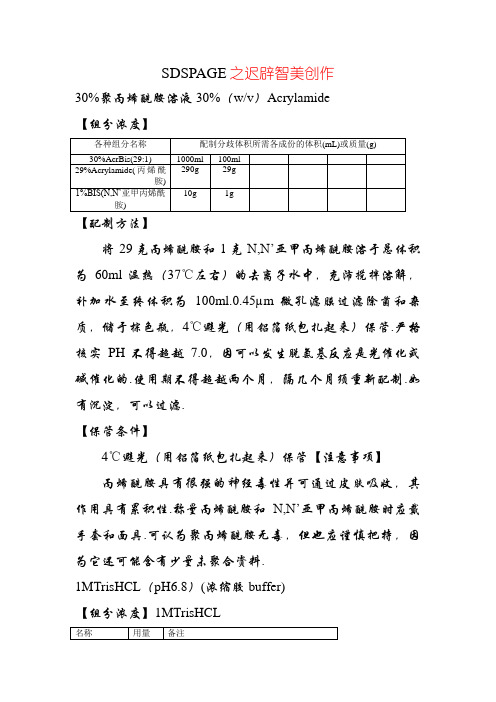
SDSPAGE之迟辟智美创作30%聚丙烯酰胺溶液30%(w/v)Acrylamide【组分浓度】【配制方法】将29克丙烯酰胺和1克N,N’亚甲丙烯酰胺溶于总体积为60ml温热(37℃左右)的去离子水中,充沛搅拌溶解,补加水至终体积为100ml.0.45µm微孔滤膜过滤除菌和杂质,储于棕色瓶,4℃避光(用铝箔纸包扎起来)保管.严格核实PH不得超越7.0,因可以发生脱氨基反应是光催化或碱催化的.使用期不得超越两个月,隔几个月须重新配制.如有沉淀,可以过滤.【保管条件】4℃避光(用铝箔纸包扎起来)保管【注意事项】丙烯酰胺具有很强的神经毒性并可通过皮肤吸收,其作用具有累积性.称量丙烯酰胺和N,N’亚甲丙烯酰胺时应戴手套和面具.可认为聚丙烯酰胺无毒,但也应谨慎把持,因为它还可能含有少量未聚合资料.1MTrisHCL(pH6.8)(浓缩胶buffer)【组分浓度】1MTrisHCL【配制方法】称量121.1gTris碱溶于800mL的去离子水,充沛搅拌溶解,加>0.7mL的浓HCL调节所需要的pH值(7.4年夜约0.7mL,7.6年夜约0.6mL,8.0年夜约0.42mL),将溶液定容至1L,高温高压灭菌后,室温保管.应使溶液冷却至室温后再调定pH值,因为Tris溶液的pH值随温度的变动不同很年夜,温度每升高1℃,溶液的pH值年夜约降低0.03个单元.【保管条件】室温保管.【注意事项】对人体有安慰性,请注意适当防护.1.5MTrisHCL(pH8.8)(分离胶buffer)【配制方法】1L称量181.7gTris碱溶于800mL的去离子水,充沛搅拌溶解,加浓HCL调节所需要的pH值=8.8,将溶液定容至1L,高温高压灭菌后,室温保管.(1.5mmol/LTrisHCL(pH8.8):18.15gTris和48ml1mol/LHCL混合,加水稀释到100ml终体积.过滤后40C保管.)【保管条件】室温保管【注意事项】应使溶液冷却至室温后再调定pH值,因为Tris溶液的pH值随温度的变动不同很年夜,温度每升高1℃,溶液的pH值年夜约降低0.03个单元.10%十二烷基硫酸钠SDS溶液10%(w/v)SDS【组分浓度】10%(w/v)SDS【配制方法】称取2g高纯度的SDS置于100~200ml烧杯中,加入约16ml的去离子水,68℃加热溶解,滴加浓盐酸调节PH至7.2,定容至20ml后,室温保管【保管条件】室温保管【注意事项】保管条件: 4℃保管. 注意事项:易燃,有腐蚀性,请注意防护.易挥发,使用后请盖紧瓶盖. 为了您的平安和健康,请穿实验服并戴一次性手套把持.保管条件: 4℃保管. 注意事项:易燃,有腐蚀性,请注意防护.易挥发,使用后请盖紧瓶盖. 为了您的平安和健康,请穿实验服并戴一次性手套对人体有害,请注意防护.10%过硫酸铵溶液10%(w/v)AP【组分浓度】10%(w/v) 过硫酸铵【配制方法】称取0.1g过硫酸铵置于1.5ml离心管,加1mL去离子水奏乐溶解,4℃保管【保管条件】4℃保管【注意事项】10%过硫酸铵溶液在4℃保管时,可使用2周左右,超越期限会失去催化作用5×Tris甘氨酸电泳缓冲液 5×TrisGlycine buffer (SDSPAGE 电泳缓冲液)【组分浓度】【配制方法】称取15.1gTris,94.0g甘氨酸(glycine),5.0gSDS,用800ml蒸馏水或去离子水溶解,充沛搅拌溶解,定容至1000ml,室温保管.得0.125mol/L Tris1.25mol/L甘氨酸电极缓冲液.临用前稀释5倍.【保管条件】室温保管,两年有效.【注意事项】配制好的电泳液使用时间不宜超越两周.电泳缓冲液可以回收,回收后可再使用12次,但为了取得最佳的电泳效果,应使用新电泳液.5×SDSPAGE加样缓冲液 5×SDSPAGE Loading Buffer【组分浓度】0.25MTrisHCL(pH6.8);10%(W/V)SDS;0.5%(W/V) BPB(溴酚蓝);50%(V/V) 甘油;5%(W/V)β巯基乙醇(2ME)【配制方法】量取 1.25mL 1MTrisHCL(pH6.8),0.5g SDS,25mg BPB,2.5mL甘油,置于10mL塑料离心管中,加去离子水溶解后,定容至5mL,小份(0.5mL/份)分装,于室温保管.使用前将25μL的2ME加入到每小份中.加入2ME的Loading Buffer可在室温下保管一个月左右.【保管条件】20℃保管,至少一年有效.【注意事项】SDSPAGE卵白上样缓冲液(5X)中含少量DTT和巯基乙醇,有轻微安慰性气味,必需完全溶解后再使用.摘自Takara 商品目录实验室惯例试剂配制方法TEMED原液直接使用考马斯亮蓝R250染色液【组分浓度】0.1%(w/v)考马斯亮蓝R250,25%(v/v)异丙醇,10%(v/v)冰醋酸考马斯亮蓝染色脱色液【组分浓度】10%(v/v)醋酸,5%(v/v)乙醇。
dopamine结构式 -回复

dopamine结构式-回复"Dopamine Structure: Unraveling the Secrets of this Neurotransmitter"Introduction:Dopamine is a crucial neurotransmitter that plays a significant role in our brain's communication system. Its structure, molecular properties, and interactions within the brain have been extensively studied to understand its effects on our mood, behavior, and overall mental health. In this article, we aim to provide a comprehensive understanding of dopamine's structure, its synthesis and breakdown process, and the mechanisms through which it influences various brain functions.1. Structure of Dopamine:Dopamine belongs to a class of neurotransmitters called catecholamines, which are derived from the amino acid tyrosine. Its chemical structure consists of a phenyl ring, an ethylamine side chain, and a hydroxyl group. With a molecular formula ofC8H11NO2, dopamine's molecular weight is 153.18 g/mol. Thesecharacteristics are crucial in understanding its functionality within the brain.2. Dopamine Synthesis:Dopamine synthesis occurs primarily in the brain, specifically within the substantia nigra and ventral tegmental area. The process begins with the conversion of the amino acid tyrosine to L-DOPA by the enzyme tyrosine hydroxylase. L-DOPA is then converted to dopamine by the enzyme aromatic L-amino acid decarboxylase. This conversion process highlights the critical role of enzymes in dopamine production.3. Dopamine Receptors:Dopamine exerts its effects by binding to specific dopamine receptors located on the surface of neurons. There are five types of dopamine receptors, classified as D1 to D5. Each receptor subtype has its own unique distribution within the brain and produces varied physiological responses. The interaction between dopamine and these receptors is vital in understanding the specific effects caused by dopamine in different brain regions.4. Dopamine Pathways:Dopamine pathways are neural circuits involved in transmitting dopamine signals throughout the brain. The two most well-known dopamine pathways are the mesolimbic and mesocortical pathways. The mesolimbic pathway is responsible for reward and reinforcement, playing a crucial role in addiction. The mesocortical pathway is involved in cognitive functions, emotional processing, and motivation. Understanding these pathways provides insights into the influence of dopamine on our behavior and emotions.5. Dopamine Regulation:Dopamine levels in the brain are tightly regulated to maintain a delicate balance. Dysregulation of dopamine has been linked to various psychiatric and neurological disorders, such as Parkinson's disease and schizophrenia. The balance is achieved through various mechanisms, including reuptake, enzymatic breakdown, and interaction with other neurotransmitters. Dopamine reuptake transporters, such as the dopamine transporter (DAT), recycle dopamine back into the presynaptic neuron, effectively terminatingits action.6. Dopamine and Reward:One of the most well-known functions of dopamine is its role in the brain's reward system. Dopamine release in the nucleus accumbens, a key component of the reward circuitry, is associated with pleasurable sensations and reinforces certain behaviors. This reward system plays a crucial role in motivation, learning, and decision-making processes.7. Dopamine and Mental Health:Dysfunction in dopamine signaling has been implicated in several mental health disorders. For example, an excess of dopamine activity is associated with conditions such as schizophrenia, while a deficiency in dopamine is observed in conditions like Parkinson's disease and depression. Understanding these imbalances is crucial for the development of effective treatments and therapies targeting these disorders.Conclusion:Dopamine's structure, synthesis, and complex interactions with the brain provide fascinating insights into its role as a key neurotransmitter. By understanding the intricate mechanisms through which dopamine influences various brain functions, researchers and scientists can continue to explore its potential therapeutic applications for mental health disorders. Further investigation into dopamine's structure may uncover additional knowledge and lead to new breakthroughs in our understanding of the brain and its complexities.。
蛋白裂解液
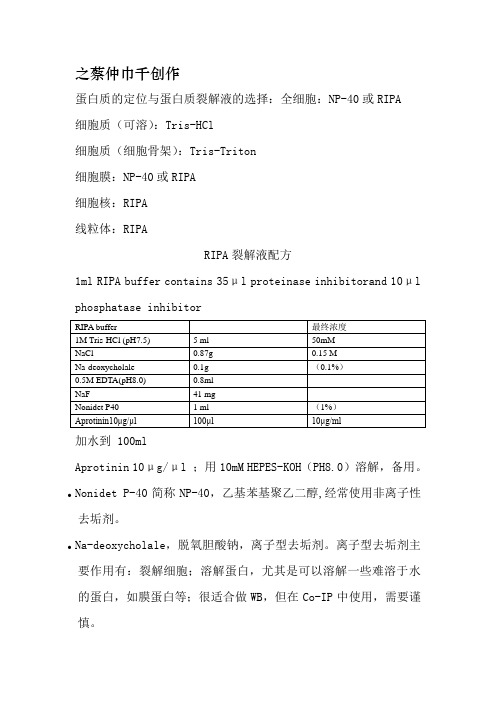
之蔡仲巾千创作蛋白质的定位与蛋白质裂解液的选择:全细胞:NP-40或RIPA细胞质(可溶):Tris-HCl细胞质(细胞骨架):Tris-Triton细胞膜:NP-40或RIPA细胞核:RIPA线粒体:RIPARIPA裂解液配方1ml RIPA buffer contains 35μl proteinase inhibitorand 10μl phosphatase inhibitor加水到 100mlAprotinin 10μg/μl ;用10mM HEPES-KOH(PH8.0)溶解,备用。
●Nonidet P-40简称NP-40,乙基苯基聚乙二醇,经常使用非离子性去垢剂。
●Na-deoxycholale,脱氧胆酸钠,离子型去垢剂。
离子型去垢剂主要作用有:裂解细胞;溶解蛋白,尤其是可以溶解一些难溶于水的蛋白,如膜蛋白等;很适合做WB,但在Co-IP中使用,需要谨慎。
●亮抑霉肽(Leupeptin):抑制丝氨酸蛋白酶包含胰蛋白酶、纤溶酶、猪胰激肽原酶)和半胱氨酸蛋白酶(包含木瓜蛋白酶和组织蛋白酶B)●抑肽素A(Pepstatin A)抑制各种天门冬氨酸蛋白酶,例如组织蛋白酶D、肾素、胃蛋白酶、细菌天门冬氨酸蛋白酶和HIV蛋白酶;●胰凝乳蛋白酶抑制剂(Chymostatin)抑制具有糜蛋白酶类特异性丝氨酸蛋白酶(包含糜蛋白酶、胃促胰酶、组织蛋白酶 G)和大多数丝氨酸蛋白酶(包含组织蛋白酶B,H,L)●抗木瓜蛋白酶(Antipain)抑制木瓜蛋白酶、胰蛋白酶和纤溶酶。
●氟化钠抑制酸性磷酸酶●正钒酸钠:抑制碱性磷酸酶和酪氨酸磷酸酶(tyrosine phosphatase)●焦磷酸钠(sodium pyrophosphate):抑制丝氨酸-苏氨酸磷酸酶(serine-threonine phosphatase)。
在与蛋白相关的检测中,首先最关键的一步即是蛋白质的提取。
蛋白质的提取过程中,我们要经常加和蛋白酶抑制剂以防止蛋白质的降解。
医药包装材料中酰胺类爽滑剂气相色谱—质谱法测定

医药包装材料中酰胺类爽滑剂气相色谱—质谱法测定龚强;丁利;罗斯斯;付善良;成婧;朱绍华;焦艳娜;王利兵【摘要】药品包装材料安全作为药品安全的重要组成部分,越来越受世界各国的重视.通过优化升温程序建立3种脂肪酸酰胺类爽滑剂的气相色谱质谱(GC MS)的检测方法.分别用正己烷、异丙醇、氯仿、正己烷/异丙醇、正己烷/氯仿和氯仿/异丙醇几种提取溶剂对医药类包装材料进行3种爽滑剂的添加回收试验.并比较分析振荡提取、索氏提取、压力溶剂萃取、超声辅助提取等不同提取方式下的提取效率.结果表明:采用氯仿/异丙醇作为提取试剂超声提取30 min,提取效率最好.该方法前处理简单、检测灵敏度高、重复性好,适于医用包装材料中爽滑剂的测定.【期刊名称】《食品与机械》【年(卷),期】2014(030)005【总页数】4页(P83-86)【关键词】医药类;包装材料;爽滑剂;气相色谱—质谱法【作者】龚强;丁利;罗斯斯;付善良;成婧;朱绍华;焦艳娜;王利兵【作者单位】湖南出入境检验检疫局技术中心食品安全科学技术湖南省重点实验室,湖南长沙410004;湖南出入境检验检疫局技术中心食品安全科学技术湖南省重点实验室,湖南长沙410004;上海出入境检验检疫局,上海200135;湖南出入境检验检疫局技术中心食品安全科学技术湖南省重点实验室,湖南长沙410004;湖南出入境检验检疫局技术中心食品安全科学技术湖南省重点实验室,湖南长沙410004;湖南出入境检验检疫局技术中心食品安全科学技术湖南省重点实验室,湖南长沙410004;湖南出入境检验检疫局技术中心食品安全科学技术湖南省重点实验室,湖南长沙410004;湖南出入境检验检疫局技术中心食品安全科学技术湖南省重点实验室,湖南长沙410004【正文语种】中文药品包装是药品生产的最后一道工序。
直接接触药品的包装材料,是药品质量的重要组成部分,其质量对于保障药品安全极为关键。
在保护药品质量安全的同时,药品包装材料安全中有害物质的迁移、包装废弃物中有害物质向环境的释放等各种不安全因素也越来越受到世界各国的重视[1]。
氨基聚乙二醇-1,2-二硬脂酰甘油磷酰乙醇胺的合成
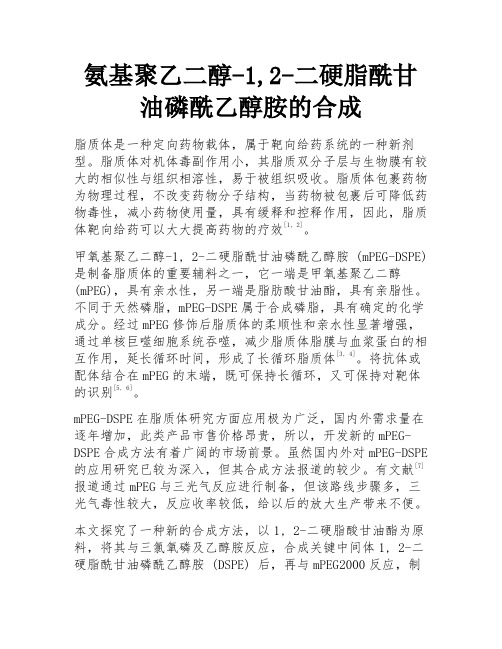
氨基聚乙二醇-1,2-二硬脂酰甘油磷酰乙醇胺的合成脂质体是一种定向药物载体,属于靶向给药系统的一种新剂型。
脂质体对机体毒副作用小,其脂质双分子层与生物膜有较大的相似性与组织相溶性,易于被组织吸收。
脂质体包裹药物为物理过程,不改变药物分子结构,当药物被包裹后可降低药物毒性,减小药物使用量,具有缓释和控释作用,因此,脂质体靶向给药可以大大提高药物的疗效[1, 2]。
甲氧基聚乙二醇-1, 2-二硬脂酰甘油磷酰乙醇胺 (mPEG-DSPE) 是制备脂质体的重要辅料之一,它一端是甲氧基聚乙二醇(mPEG),具有亲水性,另一端是脂肪酸甘油酯,具有亲脂性。
不同于天然磷脂,mPEG-DSPE属于合成磷脂,具有确定的化学成分。
经过mPEG修饰后脂质体的柔顺性和亲水性显著增强,通过单核巨噬细胞系统吞噬,减少脂质体脂膜与血浆蛋白的相互作用,延长循环时间,形成了长循环脂质体[3, 4]。
将抗体或配体结合在mPEG的末端,既可保持长循环,又可保持对靶体的识别[5, 6]。
mPEG-DSPE在脂质体研究方面应用极为广泛,国内外需求量在逐年增加,此类产品市售价格昂贵,所以,开发新的mPEG-DSPE合成方法有着广阔的市场前景。
虽然国内外对mPEG-DSPE 的应用研究已较为深入,但其合成方法报道的较少。
有文献[7]报道通过mPEG与三光气反应进行制备,但该路线步骤多,三光气毒性较大,反应收率较低,给以后的放大生产带来不便。
本文探究了一种新的合成方法,以1, 2-二硬脂酸甘油酯为原料,将其与三氯氧磷及乙醇胺反应,合成关键中间体1, 2-二硬脂酰甘油磷酰乙醇胺 (DSPE) 后,再与mPEG2000反应,制备mPEG2000-DSPE (图式1)。
该方法具有操作简单、收率高、三废少等优点,有较好的应用前景。
1 实验部分1.1 仪器与试剂上海精密科学仪器SGW X-4显微熔点测试仪;Bruker Vector 22 (4000~400 cm-1) 红外光谱仪;Varian Mercury Plus 300型核磁共振谱仪 (CDCl3为溶剂,TMS作内标);Mariner电喷雾质谱仪。
高密度发酵产酪氨酸酚裂解酶及催化合成L-DOPA
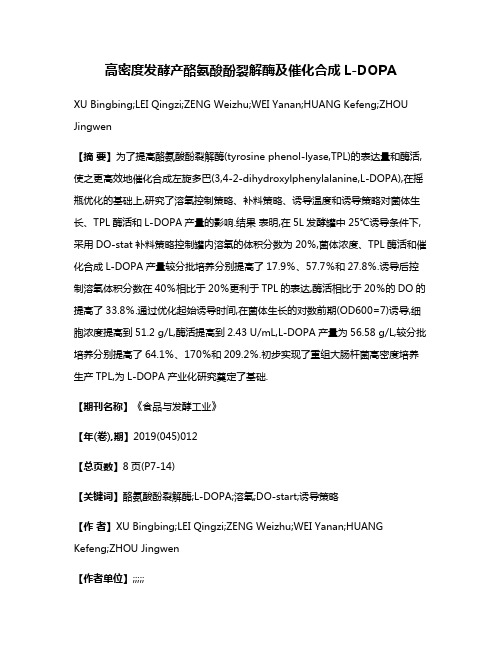
高密度发酵产酪氨酸酚裂解酶及催化合成L-DOPAXU Bingbing;LEI Qingzi;ZENG Weizhu;WEI Yanan;HUANG Kefeng;ZHOU Jingwen【摘要】为了提高酪氨酸酚裂解酶(tyrosine phenol-lyase,TPL)的表达量和酶活,使之更高效地催化合成左旋多巴(3,4-2-dihydroxylphenylalanine,L-DOPA),在摇瓶优化的基础上,研究了溶氧控制策略、补料策略、诱导温度和诱导策略对菌体生长、TPL酶活和L-DOPA产量的影响.结果表明,在5L发酵罐中25℃诱导条件下,采用DO-stat补料策略控制罐内溶氧的体积分数为20%,菌体浓度、TPL酶活和催化合成L-DOPA产量较分批培养分别提高了17.9%、57.7%和27.8%.诱导后控制溶氧体积分数在40%相比于20%更利于TPL的表达,酶活相比于20%的DO的提高了33.8%.通过优化起始诱导时间,在菌体生长的对数前期(OD600=7)诱导,细胞浓度提高到51.2 g/L,酶活提高到2.43 U/mL,L-DOPA产量为56.58 g/L,较分批培养分别提高了64.1%、170%和209.2%.初步实现了重组大肠杆菌高密度培养生产TPL,为L-DOPA产业化研究奠定了基础.【期刊名称】《食品与发酵工业》【年(卷),期】2019(045)012【总页数】8页(P7-14)【关键词】酪氨酸酚裂解酶;L-DOPA;溶氧;DO-start;诱导策略【作者】XU Bingbing;LEI Qingzi;ZENG Weizhu;WEI Yanan;HUANG Kefeng;ZHOU Jingwen【作者单位】;;;;;【正文语种】中文左旋多巴(3,4-2-dihydroxylphenylalanine,L-DOPA),又名3-羟基-L-酪氨酸,是一种前体药物,可通过血脑屏障进入脑循环而达中枢神经系统,在脱羧酶的作用下转变为多巴胺,从而达到治疗帕金森综合症的效果[1]。
SDSPAGE所有详细试剂配方
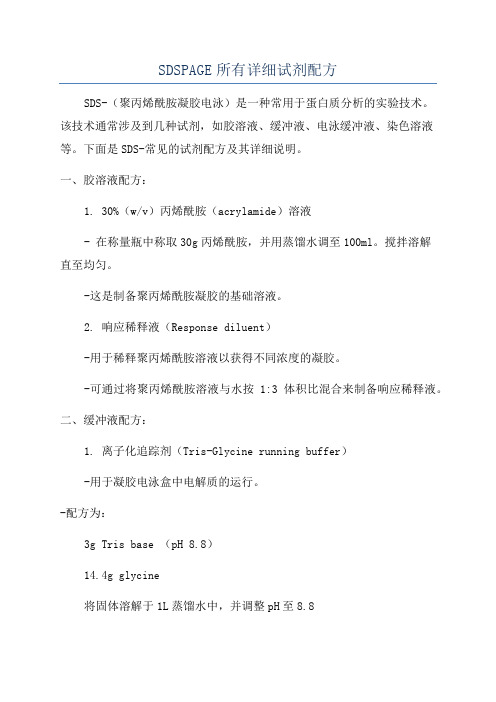
SDSPAGE所有详细试剂配方SDS-(聚丙烯酰胺凝胶电泳)是一种常用于蛋白质分析的实验技术。
该技术通常涉及到几种试剂,如胶溶液、缓冲液、电泳缓冲液、染色溶液等。
下面是SDS-常见的试剂配方及其详细说明。
一、胶溶液配方:1. 30%(w/v)丙烯酰胺(acrylamide)溶液- 在称量瓶中称取30g丙烯酰胺,并用蒸馏水调至100ml。
搅拌溶解直至均匀。
-这是制备聚丙烯酰胺凝胶的基础溶液。
2. 响应稀释液(Response diluent)-用于稀释聚丙烯酰胺溶液以获得不同浓度的凝胶。
-可通过将聚丙烯酰胺溶液与水按1:3体积比混合来制备响应稀释液。
二、缓冲液配方:1. 离子化追踪剂(Tris-Glycine running buffer)-用于凝胶电泳盒中电解质的运行。
-配方为:3g Tris base (pH 8.8)14.4g glycine将固体溶解于1L蒸馏水中,并调整pH至8.8三、电泳缓冲液配方:1. 离子化追踪剂(Tris-Glycine SDS running buffer)-用于在电泳过程中提供离子追踪剂。
-配方为:30g Tris base144g glycine10gSDS将固体溶解于1L蒸馏水中。
2. 加速剂(stacking gel buffer)- 用于形成凝胶中的聚集堆积层(stacking layer)。
-配方为:30g Tris base (pH 6.8)144g glycine1gSDS将固体溶解于1L蒸馏水中,并调整pH至6.8四、样品处理缓冲液配方:1. 样品加载缓冲液(sample loading buffer)-用于处理蛋白样品,以便在凝胶上获得良好的分离效果。
-配方为:0.5M Tris-HCl(pH 6.8)20%(v/v)甘油10%(w/v)SDS0.05%(w/v)溴酚蓝(bromophenol blue)旋转混合并加入蛋白样品。
五、凝胶染色溶液配方:1. 吸附性染色剂(Coomassie blue staining solution)-用于染色聚丙烯酰胺凝胶上分离的蛋白质。
- 1、下载文档前请自行甄别文档内容的完整性,平台不提供额外的编辑、内容补充、找答案等附加服务。
- 2、"仅部分预览"的文档,不可在线预览部分如存在完整性等问题,可反馈申请退款(可完整预览的文档不适用该条件!)。
- 3、如文档侵犯您的权益,请联系客服反馈,我们会尽快为您处理(人工客服工作时间:9:00-18:30)。
Inhibitors, Agonists, Screening LibrariesSafety Data Sheet Revision Date:May-24-2017Print Date:May-24-20171. PRODUCT AND COMPANY IDENTIFICATION1.1 Product identifierProduct name :Fenoldopam (mesylate)Catalog No. :HY-B0735ACAS No. :67227-57-01.2 Relevant identified uses of the substance or mixture and uses advised againstIdentified uses :Laboratory chemicals, manufacture of substances.1.3 Details of the supplier of the safety data sheetCompany:MedChemExpress USATel:609-228-6898Fax:609-228-5909E-mail:sales@1.4 Emergency telephone numberEmergency Phone #:609-228-68982. HAZARDS IDENTIFICATION2.1 Classification of the substance or mixtureGHS Classification in accordance with 29 CFR 1910 (OSHA HCS)Acute toxicity, Oral (Category 4),H302Acute aquatic toxicity (Category 1),H400Chronic aquatic toxicity (Category 1),H4102.2 GHS Label elements, including precautionary statementsPictogramSignal word No data availableHazard statement(s)H302 Harmful if swallowed.H410 Very toxic to aquatic life with long lasting effects.Precautionary statement(s)P264 Wash skin thoroughly after handling.P270 Do not eat, drink or smoke when using this product.P273 Avoid release to the environment.P301 + P312 IF SWALLOWED: Call a POISON CENTER or doctor/ physician if you feel unwell.P330 Rinse mouth.P391 Collect spillage.P501 Dispose of contents/ container to an approved waste disposal plant.2.3 Other hazardsNone.3. COMPOSITION/INFORMATION ON INGREDIENTS3.1 SubstancesSynonyms:Fenoldopam methanesulfonate; SKF⁻82526 mesylateFormula:C17H20ClNO6SMolecular Weight:401.86CAS No. :67227-57-04. FIRST AID MEASURES4.1 Description of first aid measuresEye contactRemove any contact lenses, locate eye-wash station, and flush eyes immediately with large amounts of water. Separate eyelids with fingers to ensure adequate flushing. Promptly call a physician.Skin contactRinse skin thoroughly with large amounts of water. Remove contaminated clothing and shoes and call a physician.InhalationImmediately relocate self or casualty to fresh air. If breathing is difficult, give cardiopulmonary resuscitation (CPR). Avoid mouth-to-mouth resuscitation.IngestionWash out mouth with water; Do NOT induce vomiting; call a physician.4.2 Most important symptoms and effects, both acute and delayedThe most important known symptoms and effects are described in the labelling (see section 2.2).4.3 Indication of any immediate medical attention and special treatment neededTreat symptomatically.5. FIRE FIGHTING MEASURES5.1 Extinguishing mediaSuitable extinguishing mediaUse water spray, dry chemical, foam, and carbon dioxide fire extinguisher.5.2 Special hazards arising from the substance or mixtureDuring combustion, may emit irritant fumes.5.3 Advice for firefightersWear self-contained breathing apparatus and protective clothing.6. ACCIDENTAL RELEASE MEASURES6.1 Personal precautions, protective equipment and emergency proceduresUse full personal protective equipment. Avoid breathing vapors, mist, dust or gas. Ensure adequate ventilation. Evacuate personnel to safe areas.Refer to protective measures listed in sections 8.6.2 Environmental precautionsTry to prevent further leakage or spillage. Keep the product away from drains or water courses.6.3 Methods and materials for containment and cleaning upAbsorb solutions with finely-powdered liquid-binding material (diatomite, universal binders); Decontaminate surfaces and equipment by scrubbing with alcohol; Dispose of contaminated material according to Section 13.7. HANDLING AND STORAGE7.1 Precautions for safe handlingAvoid inhalation, contact with eyes and skin. Avoid dust and aerosol formation. Use only in areas with appropriate exhaust ventilation.7.2 Conditions for safe storage, including any incompatibilitiesKeep container tightly sealed in cool, well-ventilated area. Keep away from direct sunlight and sources of ignition.Recommended storage temperature:Powder-20°C 3 years4°C 2 yearsIn solvent-80°C 6 months-20°C 1 monthShipping at room temperature if less than 2 weeks.7.3 Specific end use(s)No data available.8. EXPOSURE CONTROLS/PERSONAL PROTECTION8.1 Control parametersComponents with workplace control parametersThis product contains no substances with occupational exposure limit values.8.2 Exposure controlsEngineering controlsEnsure adequate ventilation. Provide accessible safety shower and eye wash station.Personal protective equipmentEye protection Safety goggles with side-shields.Hand protection Protective gloves.Skin and body protection Impervious clothing.Respiratory protection Suitable respirator.Environmental exposure controls Keep the product away from drains, water courses or the soil. Cleanspillages in a safe way as soon as possible.9. PHYSICAL AND CHEMICAL PROPERTIES9.1 Information on basic physical and chemical propertiesAppearance White to off-white (Solid)Odor No data availableOdor threshold No data availablepH No data availableMelting/freezing point No data availableBoiling point/range No data availableFlash point No data availableEvaporation rate No data availableFlammability (solid, gas)No data availableUpper/lower flammability or explosive limits No data availableVapor pressure No data availableVapor density No data availableRelative density No data availableWater Solubility No data availablePartition coefficient No data availableAuto-ignition temperature No data availableDecomposition temperature No data availableViscosity No data availableExplosive properties No data availableOxidizing properties No data available9.2 Other safety informationNo data available.10. STABILITY AND REACTIVITY10.1 ReactivityNo data available.10.2 Chemical stabilityStable under recommended storage conditions.10.3 Possibility of hazardous reactionsNo data available.10.4 Conditions to avoidNo data available.10.5 Incompatible materialsStrong acids/alkalis, strong oxidising/reducing agents.10.6 Hazardous decomposition productsUnder fire conditions, may decompose and emit toxic fumes.Other decomposition products - no data available.11.TOXICOLOGICAL INFORMATION11.1 Information on toxicological effectsAcute toxicityClassified based on available data. For more details, see section 2Skin corrosion/irritationClassified based on available data. For more details, see section 2Serious eye damage/irritationClassified based on available data. For more details, see section 2Respiratory or skin sensitizationClassified based on available data. For more details, see section 2Germ cell mutagenicityClassified based on available data. For more details, see section 2CarcinogenicityIARC: No component of this product present at a level equal to or greater than 0.1% is identified as probable, possible or confirmed human carcinogen by IARC.ACGIH: No component of this product present at a level equal to or greater than 0.1% is identified as a potential or confirmed carcinogen by ACGIH.NTP: No component of this product present at a level equal to or greater than 0.1% is identified as a anticipated or confirmed carcinogen by NTP.OSHA: No component of this product present at a level equal to or greater than 0.1% is identified as a potential or confirmed carcinogen by OSHA.Reproductive toxicityClassified based on available data. For more details, see section 2Specific target organ toxicity - single exposureClassified based on available data. For more details, see section 2Specific target organ toxicity - repeated exposureClassified based on available data. For more details, see section 2Aspiration hazardClassified based on available data. For more details, see section 212. ECOLOGICAL INFORMATION12.1 ToxicityNo data available.12.2 Persistence and degradabilityNo data available.12.3 Bioaccumlative potentialNo data available.12.4 Mobility in soilNo data available.12.5 Results of PBT and vPvB assessmentPBT/vPvB assessment unavailable as chemical safety assessment not required or not conducted.12.6 Other adverse effectsNo data available.13. DISPOSAL CONSIDERATIONS13.1 Waste treatment methodsProductDispose substance in accordance with prevailing country, federal, state and local regulations.Contaminated packagingConduct recycling or disposal in accordance with prevailing country, federal, state and local regulations.14. TRANSPORT INFORMATIONDOT (US)This substance is considered to be non-hazardous for transport.IMDGUN number: 3077Class: 9Packing group: IIIEMS-No: F-A, S-FProper shipping name: ENVIRONMENTALLY HAZARDOUS SUBSTANCE, SOLID, N.O.S.Marine pollutant: Marine pollutantIATAUN number: 3077Class: 9Packing group: IIIProper shipping name: Environmentally hazardous substance, solid, n.o.s.15. REGULATORY INFORMATIONSARA 302 Components:No chemicals in this material are subject to the reporting requirements of SARA Title III, Section 302.SARA 313 Components:This material does not contain any chemical components with known CAS numbers that exceed the threshold (De Minimis) reporting levels established by SARA Title III, Section 313.SARA 311/312 Hazards:No SARA Hazards.Massachusetts Right To Know Components:No components are subject to the Massachusetts Right to Know Act.Pennsylvania Right To Know Components:No components are subject to the Pennsylvania Right to Know Act.New Jersey Right To Know Components:No components are subject to the New Jersey Right to Know Act.California Prop. 65 Components:This product does not contain any chemicals known to State of California to cause cancer, birth defects, or anyother reproductive harm.16. OTHER INFORMATIONCopyright 2017 MedChemExpress. The above information is correct to the best of our present knowledge but does not purport to be all inclusive and should be used only as a guide. The product is for research use only and for experienced personnel. It must only be handled by suitably qualified experienced scientists in appropriately equipped and authorized facilities. The burden of safe use of this material rests entirely with the user. MedChemExpress disclaims all liability for any damage resulting from handling or from contact with this product.Caution: Product has not been fully validated for medical applications. For research use only.Tel: 609-228-6898 Fax: 609-228-5909 E-mail: tech@Address: 1 Deer Park Dr, Suite Q, Monmouth Junction, NJ 08852, USA。
